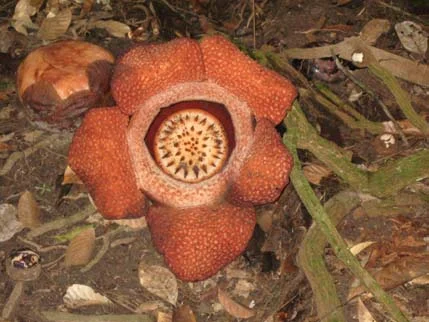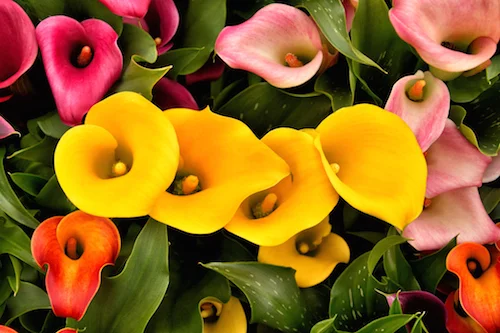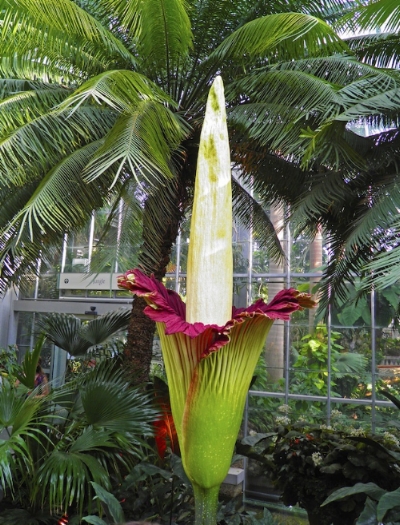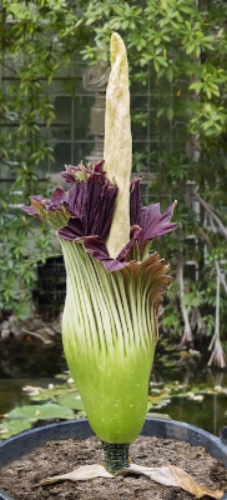The two largest flowers grow in rainforest.
The biggest flower in the world is rafflesia.
It can be one metre across!
Another big flower in the rainforest is titan arum.
The flower is about 3 metres tall.
Both flowers have a dreadful smell to attract insects.
The two largest flowers in the world both grow in Southeast Asian rainforests.
Rafflesia
There are over 17 species, or kinds, of rafflesia, all bearing large blooms, but one of them, with the scientific name of Rafflesia arnoldii, bears the largest individual flower in the world, measuring about 1 metre across and weighing up to 10 kg.
The rafflesia species was named after Sir Thomas Stamford Raffles who, in 1818, led an expedition into the rainforest that led to its discovery.
Rafflesia arnoldii © Getty Images
Rafflesia arnoldii is found only in Borneo and on the Indonesian island of Sumatra.
Rafflesia is one of a group of plants that do not convert sunlight into energy like other plants, has no roots or leaves, and is in fact a parasite. This means it grows on another plant, which is called the host plant, and takes nutrition from it. Rafflesia is a parasite on only one plant, the tetra stigma vine, a member of the grape family that lives only in rainforests.
The bud of rafflesia arnoldii emerges through the bark of the host plant. © Getty Images
The main part of rafflesia is invisible most of the time, hidden inside the woody stem of its host. The large rafflesia bud emerges through the bark of the host plant, and slowly, over a few months, develops into a huge flower that is either male or female. There are five large, fleshy, bumpy petals attached to a large cup. In the centre of the cup there is a column with a disk, underneath which are the male or female parts of the plant. The fruits are berries with tiny seeds.
A dreadful smell!
As if the sheer size of the flower is not enough, it has a strong and most dreadful smell of rotting flesh, which gives rafflesia the local name of ‘corpse flower’. However, this smell is irresistible to carrion-flies which crawl all over the flower. In doing so, pollen sticks to the backs of the flies. The plant’s survival depends on flies who visit a male flower first and then fly away to find a female rafflesia, where they will deposit the pollen. The rafflesia flower lasts only 5 or 6 days.
Conservation status and threats
Rafflesia species are rare for several reasons, some classified as vulnerable, others as Endangered.
They have what is known as a double specialisation: they can only grow on one species of vine, which in turn is only found in very specific habitats.
Only about 20% of buds survive to bloom.
There seem to be more male flowers than female, and they bloom for a very short time, which makes the chances very small of a male and female blooming at the same time close enough together to be pollinated.
In addition to these natural threats, Southeast Asian rainforests are being destroyed at a great rate, and rafflesia buds are also harvested for use in traditional medicine, although scientific research has proven that this belief is not based on fact.
Habitat protection is one of the keys to the survival of these plants.
Rafflesia species are protected in a number of reserves.
Rafflesia arnoldii has not been assessed by the IUCNRed List, but is considered to be vulnerable because of disturbance of the forests by tour groups hoping to see it. However this interest is an incentive to local people to preserve the plant because it brings tourism money to the economy.
Titan arum
The titan arum is found in the wild only in the rainforests of the Indonesian island of Sumatra.
It has a giant flowering structure. It flowers rarely and unpredictably, but always spectacularly. It is the biggest inflorescence in the world: rather than being a single flower it is in fact a group of many flowers.
The common calla lilies are part of the same arum family, and can be seen in many gardens. ©Getty
The flower structure of all arum and calla plants consists of a spathe, rather like a tall, stiff collar, wrapped around a spike-shaped spadix.
A titan arum in flower in the Kew Gardens in London. ©Getty
The flower is a composite, or collection of a number of flowers together, and there is a band each of male and female flowers on the lower part of the spadix, protected by the spathe.
However, the spathe of the titan arum is more like a frilly upturned bell in shape, a speckled green on the outside and a deep purplish red on the inside. The stalk is only about 30 cm high but the whole flower itself is up to 3 metres tall. The plant produces only one leaf at a time, a huge leaf that can be around 6 metres long and 4.5 metres wide.
The huge leaves and flowers grow from a large tuber under the ground. A tuber is an underground stem that stores food for the plant. The spherical tuber of the titan arum is the largest of all plant tubers, weighing over 70 kg.
The plant can go for several years without flowering. Then a large bud appears on the forest floor, and grows with amazing speed – about 10 cm a day.
This flower is not fully open. You can see how short the stem is. ©Getty
The flower first opens at night, and becomes so hot it steams. Once the flower is fully open, it emits a dreadful smell of rotting fish . This attracts tiny sweat bees from far away, and they enter the spathe, bringing pollen with them, and get trapped. They cannot climb up the smooth sides and stay inside the plant gathering nectar from the female flowers. The next day the male flowers release their pollen and the spike begins to wither, which allows the insects to escape, brushing against the pollen as they do. Once pollinated, the female parts of the plant develop into red fruits the size of olives, in a cluster about 50cm long.
The flower lasts for only about 3 days before collapsing and twisting around the base, protecting the fruit inside. The fruits ripen and the spathe rots away completely, leaving the berries on display for birds to find and eat, then disperse them to other parts of the forest in their poo.
Conservation status and Threats
Titan arum is classified as Vulnerable.
Vast areas of Sumatran rainforests are being cut down to make way for palm plantations, thus threatening the habitat of many species of plant and animal unique to the island.
The titan arum has proved to be difficult to cultivate outside of its habitat, and just a few have been grown and can be seen in botanic gardens that specialise in rare and unique plants, including the Botanic Gardens in both Melbourne and Sydney, Australia.
It is always a good idea to use more than one source of information so: watch a video showing rafflesia arnoldii in flower and in bud
https://www.youtube.com/watch?v=0cGRujABwuQ






